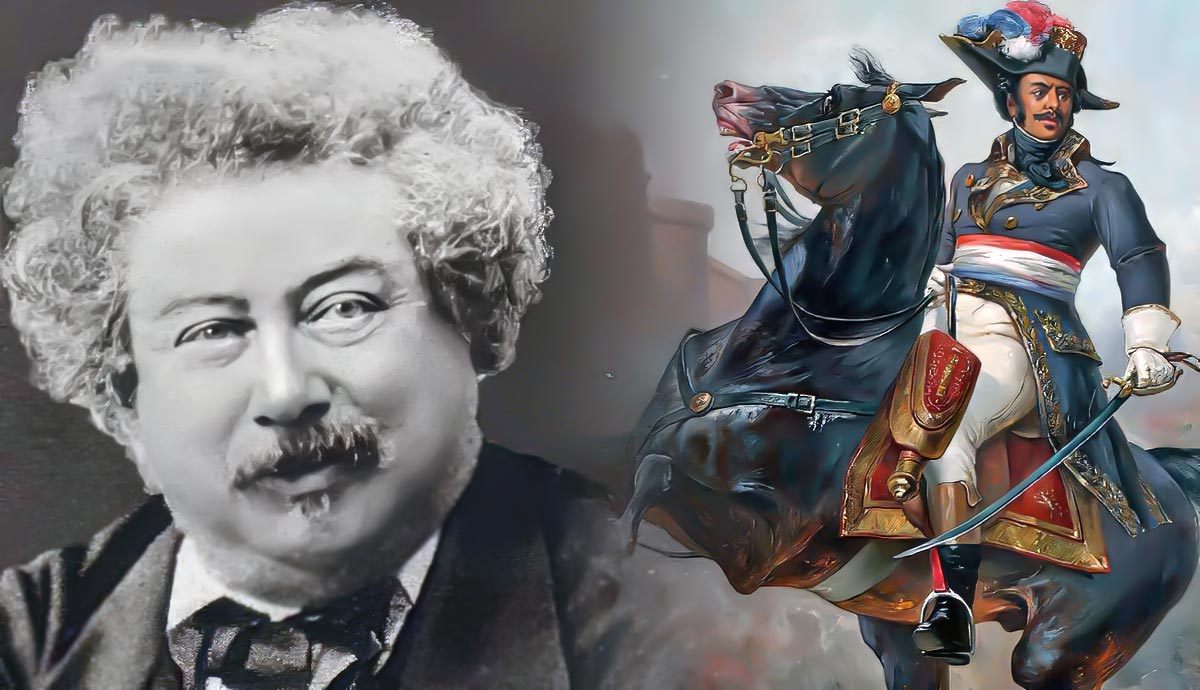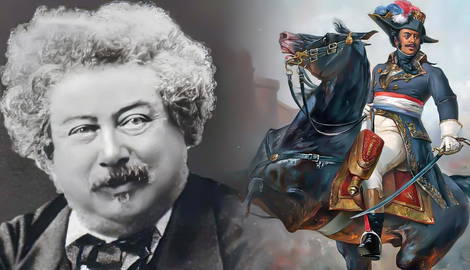
summary
- Alexandre Dumas’ African heritage: French author Alexandre Dumas’s father, Thomas-Alexandre Dumas, was born into slavery but later became a general in the French army. His paternal grandfather was a French aristocrat, and his grandmother was an enslaved woman of African descent.
- Alexandre Dumas faced racism: Alexandre Dumas’ family history and experiences with racism influenced his literary work, which was often dismissed by the literary establishment for a long time. His biracial ancestry was also overlooked at the time.
- Alexandre Dumas’s legacy: In 2002, Alexandre Dumas was reinterred at the Panthéon in Paris, and the French president acknowledged the racism he had endured.
With his flair for storytelling, Alexandre Dumas became one of France’s most enduringly popular authors. As the grandson of a French aristocrat and the enslaved woman he bought to be his concubine, however, he suffered racist abuse throughout his life. Racist prejudices may have led to the devaluing of his literary work even after his death. At the same time, it can be argued that he has become something of a hidden figure within Black History, or rather, a figure hidden in plain sight. Here, we will take a closer look at Dumas’ family background and the ways in which contemporary racist attitudes informed some of his writing.
Who Were Alexandre Dumas’ Grandparents?

Alexandre Dumas is descended from French aristocracy through his paternal grandfather, Alexandre Antoine Davy de la Pailleterie. The eldest of three sons, Alexandre Antoine Davy de la Pailleterie was born on June 20th, 1714, in Belleville-en-Caux to Jeanne-Françoise Paultre and the Marquis Alexandre Davy de la Pailleterie. Though the family were provincial Norman aristocrats, their fortune was declining. All three sons pursued military careers, with Alexandre Antoine attaining the rank of colonel. At the age of 20, Alexandre Antoine was involved in the 1734 Siege of Philippsburg.
Two years before the siege, Alexandre Antoine’s younger brother Charles took up a military post in Saint-Domingue, which, at the time, was a French colony that generated vast sums through the exploitation of slave labor on its sugar plantations. In 1738, Charles gave up his military career in order to pursue the more lucrative role of a sugar planter, marrying Anne-Marie Tuffé, a wealthy woman of mixed race, and began to run her estate.
In the same year, Alexandre Antoine also left the military to live and work with his brother until 1748, by which time fraternal relations had soured. Though he remained on the island, he had no further contact with his brother—or, indeed, the rest of his family—for 30 years. Under the name Antoine de l’Isle, he became a coffee and cacao planter and purchased Marie-Cessette Dumas, an enslaved woman of African descent who then became his concubine. In 1762, she gave birth to their son, Thomas-Alexandre, who (like his son after him) assumed the surname Dumas rather than his father’s aristocratic surname. The name Dumas was thus an inheritance from his enslaved mother and is believed to mean “of the farm” (du mas), referring to her status as property.
Who Were Alexandre Dumas’ Parents?

Alexandre Dumas’ father, Thomas-Alexandre Dumas, was born in 1762 in the French colony of Saint-Domingue (now known as Haiti). His parents had two daughters, and his mother also had an older daughter from before she had been bought by Alexandre Antoine. Because of their mother’s status as an enslaved person, Thomas-Alexandre and his sisters were also all born into slavery.
In 1757, Alexandre Antoine’s mother passed away, and his father, too, died the following year. Despite not being the eldest son, Charles traveled back to Normandy to claim the family château and title before dying of gout in 1773. Louis, the youngest of the three brothers, also died shortly after, meaning the family title and property fell to Alexandre Antoine.
In 1775, therefore, Alexandre Antoine returned to France with his illegitimate son, Thomas-Alexandre, in tow. As slavery was outlawed in France, Thomas-Alexandre’s arrival there de facto granted him his freedom, and his father had him enrolled in military school. However, before leaving Saint-Domingue, Alexandre Antoine had sold Marie-Cessette and her three daughters to a fellow aristocrat from Nantes.
It is unclear what happened to Marie-Cessette after this point. According to two documents signed by Thomas-Alexandre, she died in La Guinaudée, near Trou Jérémie, Saint-Domingue, in 1772. However, two later documents from 1775 and 1801 suggest that she was, in fact, still alive.
However, one of the documents signed by Thomas-Alexandre, in which it is alleged that Marie-Cessette died in 1772, was his marriage certificate. While stationed in Amiens with the Black Legion, he married Marie-Louise Élisabeth Labouret, the daughter of an innkeeper, on November 28th, 1792, in Villers-Cotterêts. It is, therefore, likely that Thomas-Alexandre was anxious to avoid having to secure his mother’s permission to marry and so disclose her status as an enslaved person.

While his mother and sisters remained in slavery, Thomas-Alexandre went on to distinguish himself in his military career and was promoted to the rank of general by the age of 31. In doing so, he became the first soldier of Afro-Caribbean heritage to reach that rank in the French army. After marrying Marie-Louise, he bought a 30-acre farm where the couple raised their two daughters, Marie-Alexandrine and Louise Alexandrine, and their only son, Alexandre Dumas.
In 1799, however, he was captured at Taranto in the Kingdom of Naples by the Holy Faith Army led by Cardinal Fabrizio Ruffo. The Holy Faith Army was in alliance with King Ferdinand IV of the Kingdom of Naples, who was at war with France at the time. Thomas-Alexandre was imprisoned by his captors for two years. His wife appealed to Napoleon Bonaparte (who had seized power in 1799) and his government, but Thomas-Alexandre was only released following Napoleon’s defeat of Ferdinand IV in 1801. By this time, he was left partially blind in one eye, physically disabled, and believed he had been routinely poisoned during his captivity.
Despite this, he was not granted the military pension customarily allocated to generals in the French army. Despite his frailty, he struggled to support his young family and repeatedly appealed to Napoleon for another military commission.
On February 26th, 1806, he died of stomach cancer, leaving his family in ever more dire straits. His son, Alexandre Dumas, was just three years old at the time of his father’s death and would not even be able to attain secondary education, such was the family’s impoverishment.
How Did Racism Affect Dumas’ Life and Work?

Despite his aristocratic heritage, Alexandre Dumas encountered racism throughout his life as a man of mixed race in 19th-century France. While he generally did not write of his African heritage, he drew on his family history and his personal experience of racism in writing his 1839 children’s novel Captain Pamphile (in which he sought to impart an overtly anti-slavery message) and his 1843 novella Georges.
Set on the Isle of France (now Mauritius), Georges centers on the eponymous protagonist, the mixed-race son of a planter. While he endures racist abuse from the other white planters on the island, when he is sent to France to be educated, he finds he can “pass” as white. For a while, he enjoys the life of a Parisian socialite but feels compelled to return to the island, where he leads the enslaved population in a revolt against their white owners.
Some literary critics and historians believe that Dumas also drew on his family history in writing The Count of Monte Cristo (1844-46). When the British imposed a naval blockade on French shipping during the Seven Years’ War, Dumas’ great-uncle Charles took to smuggling his sugar exports out of Saint-Domingue to the neutral island then known as Monte Cristo.
How Did Racism Affect Alexandre Dumas’ Literary Legacy?

When Dumas was reinterred at the mausoleum of the Panthéon in Paris in 2002, the then French president Jacques Chirac addressed the racism Dumas had endured, in life and after death, and expressed the hope that this reinterment would go some way to righting that wrong.
For a long time, Dumas’s literary contributions were not as celebrated as those of other French authors and sometimes excluded from the traditional French literary canon. Some scholars suggest that racist discourse influenced critics’ approach to the literary and aesthetic matters in Alexandre Dumas’ writing. This bias limited his recognition and influence for many years.
While the literary establishment long dismissed Dumas’s work and overlooked his biracial ancestry, there is reason for hope that his work and his role within Black History will continue to be celebrated for many more years to come.
FAQs
What was Alexandre Dumas’s ethnicity?
Alexandre Dumas was of mixed heritage. His father, Thomas-Alexandre Dumas, was born in Haiti (then Saint-Domingue) to a French nobleman, Alexandre Antoine Davy de la Pailleterie, and Marie-Cessette, an enslaved woman of African descent. Alexandre Dumas was aware and seemingly proud of his heritage. He used the surname “Dumas,” which was his enslaved grandmother’s name, rather than his father’s aristocratic name
How did Alexandre Dumas’ mixed-race ancestry influence his literary work?
Alexandre Dumas’s heritage played a crucial role in shaping his life experiences and perspectives, which in turn influenced his literary creations. Indeed, his works often touched upon themes of identity, social justice, and the struggle against adversity, reflecting his own experiences and observations as a man of mixed heritage in 19th-century French society.
Did Alexandre Dumas write about his African heritage?
While Alexandre Dumas generally did not write directly about his African heritage, he did draw on his family history and experiences with racism in some of his works, particularly his novel Georges, which directly addressed racial issues and the effects of colonialism. The protagonist, a man of mixed race, navigates the complexities of identity and prejudice in a colonial setting.










